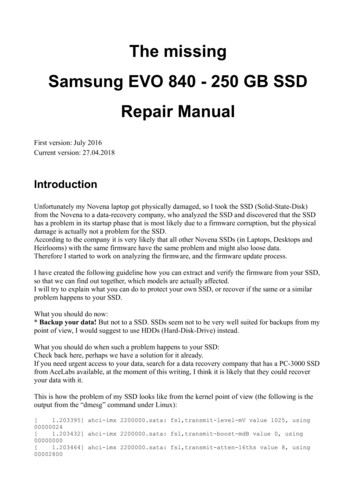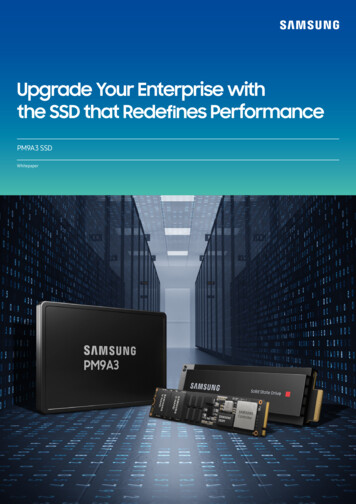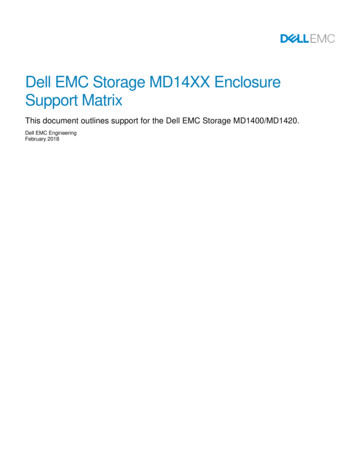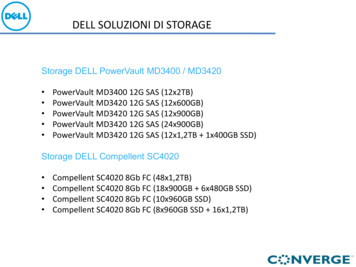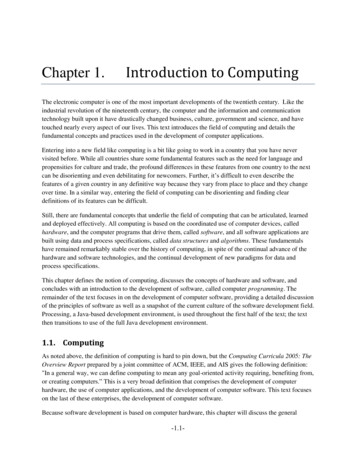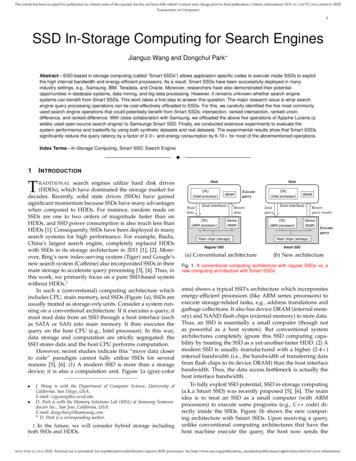
Transcription
This article has been accepted for publication in a future issue of this journal, but has not been fully edited. Content may change prior to final publication. Citation information: DOI 10.1109/TC.2016.2608818, IEEETransactions on Computers1SSD In-Storage Computing for Search EnginesJianguo Wang and Dongchul Park Abstract—SSD-based in-storage computing (called ”Smart SSDs”) allows application-specific codes to execute inside SSDs to exploitthe high internal bandwidth and energy-efficient processors. As a result, Smart SSDs have been successfully deployed in manyindustry settings, e.g., Samsung, IBM, Teradata, and Oracle. Moreover, researchers have also demonstrated their potentialopportunities in database systems, data mining, and big data processing. However, it remains unknown whether search enginesystems can benefit from Smart SSDs. This work takes a first step to answer this question. The major research issue is what searchengine query processing operations can be cost-effectively offloaded to SSDs. For this, we carefully identified the five most commonlyused search engine operations that could potentially benefit from Smart SSDs: intersection, ranked intersection, ranked union,difference, and ranked difference. With close collaboration with Samsung, we offloaded the above five operations of Apache Lucene (awidely used open-source search engine) to Samsungs Smart SSD. Finally, we conducted extensive experiments to evaluate thesystem performance and tradeoffs by using both synthetic datasets and real datasets. The experimental results show that Smart SSDssignificantly reduce the query latency by a factor of 2-3 and energy consumption by 6-10 for most of the aforementioned operations.Index Terms—In-Storage Computing, Smart SSD, Search EngineF1I NTRODUCTIONTRADITIONALsearch engines utilize hard disk drives(HDDs), which have dominated the storage market fordecades. Recently, solid state drives (SSDs) have gainedsignificant momentum because SSDs have many advantageswhen compared to HDDs. For instance, random reads onSSDs are one to two orders of magnitude faster than onHDDs, and SSD power consumption is also much less thanHDDs [1]. Consequently, SSDs have been deployed in manysearch systems for high performance. For example, Baidu,China’s largest search engine, completely replaced HDDswith SSDs in its storage architecture in 2011 [1], [2]. Moreover, Bing’s new index-serving system (Tiger) and Google’snew search system (Caffeine) also incorporated SSDs in theirmain storage to accelerate query processing [3], [4]. Thus, inthis work, we primarily focus on a pure SSD-based systemwithout HDDs.1In such a (conventional) computing architecture whichincludes CPU, main memory, and SSDs (Figure 1a), SSDs areusually treated as storage-only units. Consider a system running on a conventional architecture. If it executes a query, itmust read data from an SSD through a host interface (suchas SATA or SAS) into main memory. It then executes thequery on the host CPU (e.g., Intel processor). In this way,data storage and computation are strictly segregated: theSSD stores data and the host CPU performs computation.However, recent studies indicate this “move data closerto code” paradigm cannot fully utilize SSDs for severalreasons [5], [6]. (1) A modern SSD is more than a storagedevice; it is also a computation unit. Figure 1a (gray-color J. Wang is with the Department of Computer Science, University ofCalifornia, San Diego, USA.E-mail: csjgwang@cs.ucsd.eduD. Park is with the Memory Solutions Lab (MSL) at Samsung Semiconductor Inc., San Jose, California, USA.E-mail: dongchul.p1@samsung.com D. Park is a corresponding author.1. In the future, we will consider hybrid storage includingboth SSDs and HDDs.HostCPU(Intel processor)ReaddataHostDRAM(host interface)CPU(ARM l processor)SendqueryDRAM(host interface)CPU(ARM processor)Returnquery resultsDeviceDRAMFlash chips (storage)Flash chips (storage)Regular SSDSmart SSD(a) Conventional architectureExecutequery(b) New architectureFig. 1. A conventional computing architecture with regular SSDs vs. anew computing architecture with Smart SSDsarea) shows a typical SSD’s architecture which incorporatesenergy-efficient processors (like ARM series processors) toexecute storage-related tasks, e.g., address translations andgarbage collections. It also has device DRAM (internal memory) and NAND flash chips (external memory) to store data.Thus, an SSD is essentially a small computer (though notas powerful as a host system). But conventional systemarchitectures completely ignore this SSD computing capability by treating the SSD as a yet-another-faster HDD. (2) Amodern SSD is usually manufactured with a higher (2-4 )internal bandwidth (i.e., the bandwidth of transferring datafrom flash chips to its device DRAM) than the host interfacebandwidth. Thus, the data access bottleneck is actually thehost interface bandwidth.To fully exploit SSD potential, SSD in-storage computing(a.k.a Smart SSD) was recently proposed [5], [6]. The mainidea is to treat an SSD as a small computer (with ARMprocessors) to execute some programs (e.g., C code) directly inside the SSDs. Figure 1b shows the new computing architecture with Smart SSDs. Upon receiving a query,unlike conventional computing architectures that have thehost machine execute the query, the host now sends the0018-9340 (c) 2016 IEEE. Personal use is permitted, but republication/redistribution requires IEEE permission. See http://www.ieee.org/publications standards/publications/rights/index.html for more information.
This article has been accepted for publication in a future issue of this journal, but has not been fully edited. Content may change prior to final publication. Citation information: DOI 10.1109/TC.2016.2608818, IEEETransactions on Computers2 We systematically studied the impact of Smart SSDsto search engines from a holistic system perspective.We offloaded more operations including intersection,ranked intersection, ranked union, difference, and rankeddifference (the previous version [14] only studied intersection).We integrated our design and implementation to awidely used open-source search engine – ApacheLucene2 (the previous version [14] was independentof Lucene).We conducted more comprehensive experimentswith both synthetic and real-world datasets to evaluate the performance and energy consumption (theprevious version [14] only evaluated on syntheticdatasets).The rest of this paper is organized as follows. Section 2provides an overview of the Samsung Smart SSDs we used2. https://lucene.apache.orgSSD ddedProcessorsNANDFlash NANDFlashFlash ChannelFlashControllerDRAMController query (or some query operations) to the Smart SSD. TheSmart SSD reads necessary data from flash chips to itsinternal device DRAM, and its internal processors executethe query (or query steps). Then, only results (expected to bemuch smaller than the raw data) return to the host machinethrough the relatively slow host interface. In this way, SmartSSDs change the traditional computing paradigm to “movecode closer to data” (a.k.a near-data processing [7]).Although the Smart SSD has a disadvantage that its(ARM) CPU is much less powerful (e.g., lower clock speedand higher memory access latency) than the host (Intel)CPU, it has two advantages which make it compellingfor some I/O-intensive and computationally-simple applications. (1) Data access I/O time is much less because ofthe SSD’s high internal bandwidth. (2) More importantly,energy consumption can be significantly reduced sinceARM processors consume much less energy (4-5 ) thanhost CPUs. The energy saving is dramatically importantin today’s data centers because energy takes 42% of thetotal monthly operating cost in data centers [8]; this explainswhy enterprises like Google and Facebook recently revealedplans to replace their Intel-based servers with ARM-basedservers to save energy and cooling cost [9], [10].Thus, Smart SSDs have gained significant attention fromboth industry and academia for achieving performanceand energy gains. For instance, Samsung has demonstratedSmart SSD potential in big data analytics [11]. IBM hasbegun installing Smart SSDs in Blue Gene supercomputers [12]. The research community has also investigated theopportunities of Smart SSDs in areas such as computersystems [6], databases [5], and data mining [13].However, it remains unknown whether search enginesystems (e.g., Google) can benefit from Smart SSDs for performance and energy savings. It is unarguable that searchengines are important because they are the primary meansfor finding relevant information for users, especially in theage of big data. To the best of our knowledge, this is thefirst article to evaluate the impact of using Smart SSDswith search engines. A preliminary version of this articlethat studied the impact of Smart SSD to list intersectionappeared in an earlier paper [14]. In this version, we havethe following significant new contributions:Flash ChannelNANDFlashNANDFlash NANDFlashDRAMFig. 2. Smart SSD hardware architectureand search engines. Section 3 presents the design decisions of what search engine operations can be offloaded toSmart SSDs. Section 4 provides the implementation details.Section 5 analyzes the performance and energy tradeoffs.Section 6 explains the experimental setup. Section 7 showsthe experimental results. Section 8 discusses some relatedstudies of this paper. Section 9 concludes the paper.2BACKGROUNDThis section presents the background of Smart SSDs (Section 2.1) and search engines (Section 2.2).2.1Smart SSDsThe Smart SSD ecosystem consists of both hardware (Section 2.1.1) and software components (Section 2.1.2) to execute user-defined programs.2.1.1Hardware ArchitectureFigure 2 represents the hardware architecture of a SmartSSD which is similar to regular SSD hardware architecture.In general, an SSD is largely composed of NAND flashmemory array, SSD controller, and (device) DRAM. The SSDcontroller has four main subcomponents: host interface controller, embedded processors, DRAM controller, and flashcontroller.The host interface controller processes commands fromhost interfaces (typically SAS/SATA or PCIe) and distributes them to the embedded processors.The embedded processors receive the commands andpass them to the flash controller. More importantly, theyrun SSD firmware code for computation and execute FlashTranslation Layer (FTL) for logical-to-physical address mapping [15]. Typically, the processor is a low-powered 32-bitprocessor such as an ARM series processor. Each processorhas a tightly coupled memory (e.g., SRAM) and can accessDRAM through a DRAM controller. The flash controllercontrols data transfer between flash memory and DRAM.Since the SRAM is even faster than DRAM, performancecritical codes or data are stored in the SRAM for moreeffective performance. On the other hand, typical or nonperformance-critical codes or data are loaded in the DRAM.In Smart SSD, since a developer can utilize each memoryspace (i.e., SRAM and DRAM), performance optimization istotally up to the developer.0018-9340 (c) 2016 IEEE. Personal use is permitted, but republication/redistribution requires IEEE permission. See http://www.ieee.org/publications standards/publications/rights/index.html for more information.
This article has been accepted for publication in a future issue of this journal, but has not been fully edited. Content may change prior to final publication. Citation information: DOI 10.1109/TC.2016.2608818, IEEETransactions on Computers3Host SystemHost Smart SSD ProgramQuerySession ManagementOPENOperationCLOSEGETFront-end Web ServerPUTSmart SSD DeviceMemoryX1: Parse queryS1: Get documentsX2: Get metadataS2: Parse documentsBase Device FirmwareX3: Get inverted listsS3: Fragment documentsStorage MediaX4: Execute list operations(e.g., Intersection)X5: Similarity computationand rankingS4: Similarity computationand rankingSSDletSmart SSD RuntimeFig. 3. Smart SSD software architectureIndex ServerThe NAND flash memory package is the persistent storage media. Each package is subdivided further into smallerunits that can independently execute commands or reportstatus.2.1.2ResultsSoftware ArchitectureIn addition to the hardware support, Smart SSDs need asoftware mechanism to define a set of protocols such thathost machines and Smart SSDs can communicate with eachother. Figure 3 describes our Smart SSD software architecture which consists of two main components: Smart SSDfirmware inside the SSD and host Smart SSD program in thehost system. The host Smart SSD program communicateswith the Smart SSD firmware through application programming interfaces (APIs).The Smart SSD firmware has three subcomponents: SSDlet, Smart SSD runtime, and base device firmware. AnSSDlet is a Smart SSD program in the SSD. It implements application logic and responds to a Smart SSD host program.The Smart SSD runtime system (1) executes the SSDlet inan event-driven manner, (2) connects the device Smart SSDprogram with a base device firmware, and (3) implementsthe library of Smart SSD APIs. In addition, a base devicefirmware also implements normal storage device I/O operations (read and write).This host Smart SSD program consists largely of twocomponents: a session management component and an operation component. The session component manages SmartSSD application session lifetimes so that the host SmartSSD program can launch an SSDlet by opening a SmartSSD device session. To support this session management,Smart SSD provides two APIs, namely, OPEN and CLOSE.Intuitively, OPEN starts a session and CLOSE terminatesa session. Once OPEN starts a session, runtime resourcessuch as memory and threads are assigned to run the SSDletand a unique session ID is returned to the host Smart SSDprogram. Afterwards, this session ID must be associatedto interact with the SSDlet. When CLOSE terminates theestablished session, it releases all the assigned resources andcloses SSDlet associated with the session ID.Once a session is established by OPEN, the operationcomponent helps the host Smart SSD program interact withSSDlet in a Smart SSD device with GET and PUT APIs. ThisGET operation is used to check the status of SSDlet andS5: Assemble resultsDocument ServerFig. 4. Search engine architecturereceive output results from the SSDlet if results are available.This GET API implements the polling mechanism of theSAS/SATA interface because, unlike PCIe, such traditionalblock devices cannot initiate a request to a host such asinterrupts. PUT is used to internally write data to the SmartSSD device without help from local file systems.2.2Search EnginesSearch engines (e.g., Google) provide an efficient solutionfor people to access information, especially in big data era.A search engine is a complex large-scale software systemwith many components working together to answer userqueries. Figure 4 shows the system architecture of a typicalsearch engine, which includes three types of servers: frontend web server, index server and document server [16], [17].Front-end web server. The front-end web server interacts with end users, mainly to receive users’ queries andreturn result pages. Upon receiving a query, depending onhow the data is partitioned (e.g., term-based or documentbased partitioning) [18]), it may possibly do some preprocessing before forwarding the query to an index server.Index server. The index server stores the inverted index [19] to help answer queries efficiently. An inverted indexis a fundamental data structure in any search engine [19],[20]. It can efficiently return the documents that contain aquery term. It consists of two parts: dictionary and postingfile. Dictionary. Each entry in the dictionary file has theformat of hterm, docFreq, addri, where term represents the term string, docFreq means documentfrequency, i.e., the number of documents containingthe term, while addr records the file pointer to theactual inverted list in the posting file.Posting file. Each entry in the posting file is called aninverted list (or posting list), which has a collectionof hdocID, termFreq, posi entries. Here, docIDmeans the (artificial) identifier for the documentcontaining the term, termFreq stores the how manytimes the term appears in the document, and posrecords the positions for all the occurrences wherethe term appears in the document.0018-9340 (c) 2016 IEEE. Personal use is permitted, but republication/redistribution requires IEEE permission. See http://www.ieee.org/publications standards/publications/rights/index.html for more information.
This article has been accepted for publication in a future issue of this journal, but has not been fully edited. Content may change prior to final publication. Citation information: DOI 10.1109/TC.2016.2608818, IEEETransactions on Computers4 Step X1: parse the query into a parse tree;Step X2: get the metadata for each inverted list. Themetadata is consulted for loading the inverted listfrom disks. The metadata can include offset andlength (in bytes) that the list is stored, may alsoinclude document frequency;Step X3: get the inverted list from disk to host memory, via the host I/O interface. Today, the invertedindex is too big to fit into main memory [17], [21]and thus we assume the inverted index is stored ondisks [1], [2];Step X4: do list operations depending on the querytype. The basic operations include list intersection,union and difference [22], [23];Step X5: for each qualified document, compute thesimilarity between the query and the document using a relevance model, e.g., the standard Okapi BM25model [24]. Then, return the top-k most relevant document IDs to the web server for further processing.Document server. The document server stores the actualdocuments (or web pages). It receives the query and a setof document IDs from the index server, then, generatesquery-specific snippets [25]. It also requires several queryprocessing steps (S1 to S5 in Figure 4). Step S1 is to get thedocuments from disk. Step S2–S5 generate the query-specificsnippets.This is the first study for applying Smart SSD to searchengines. We mainly focus on the index server, and leavingthe document server for future work. Based on our experience, with SSD-based search engines, index server queryprocessing takes more time than in the document server [1].Moreover, we choose Apache Lucene as our experimental system, because Lucene is a well known opensource search engine and widely adopted in industry. E.g.,LinkedIn [26] and Twitter [27] adopted Lucene in theirsearch platforms, and Lucene is also integrated into Spark3for big data analytics [28].3S MART SSD FOR S EARCH E NGINESThis section describes the system co-design of the SmartSSD and search engines. We first explore the design space(Section 3.1) to determine what query processing logiccould be cost-effectively offloaded, and then show the codesign architecture of the Smart SSD and search engines(Section 3.2).3.1Design SpaceThe overall co-design research question is what query processing logic could Smart SSDs cost-effectively execute? To answerthis, we must understand Smart SSD opportunities andlimitations.Smart SSD Opportunities. Executing I/O operationsinside Smart SSDs is very fast for two reasons.3. http://spark.apache.org/60query latency (ms)The index server receives a query and returns the topk most relevant document IDs, by going through severalmajor steps (X1 to X5 in Figure 4).Step S1Step S2Step S3Step S4Step S550403020100I/O timeCPU timeFig. 5. Time breakdown of executing a typical real-world query byLucene system running on regular SSDs(1) SSD internal bandwidth is generally several timeshigher than the host I/O interface bandwidth [5], [29].(2) The I/O latency inside Smart SSDs is very low comparedto regular I/Os the host systems issue. A regular I/Ooperation (from flash chips to the host DRAM) mustgo through an entire, thick OS stack, which introducessignificant overheads such as interrupt, context switch,and file system overheads. This OS software overheadbecomes a crucial factor in SSDs due to their fast I/O(but it can be negligible with HDDs as their slow I/Odominates system performance) [30]. However, an internal SSD I/O operation (from flash chips to the internalSSD DRAM) is free from this OS software overhead.Thus, it is very advantageous to execute I/O-intensiveoperations inside SSDs to leverage their high internal bandwidth and low I/O latency.Smart SSD Limitations. Smart SSDs also have somelimitations.(1) Generally, Smart SSDs employ low-frequency processors(typically ARM series) to save energy and manufacturing cost. As a result, computing capability is severaltimes lower than host CPUs (e.g., Intel processor) [5],[29];(2) The Smart SSD also has a DRAM inside. Accessing thedevice DRAM is slower than the host DRAM becausetypical SSD controllers do not have sufficient caches.Therefore, it is not desirable to execute CPU-intensive andmemory-intensive operations inside SSDs.Smart SSDs can reduce the I/O time at the expenseof the increasing CPU time so that a system with I/Otime bottleneck can notably benefit from Smart SSDs. Asan example, the Lucene system running on regular SSDshas an I/O time bottleneck, see Figure 5 (please refer toSection 6 for more experimental settings). We observe theI/O time of a typical real-world query is 54.8 ms while itsCPU time is 8 ms. Thus, offloading this query to Smart SSDscan significantly reduce the I/O time. Figure 7 in Section 7supports this claim. If we offload steps S3 and S4 to SmartSSDs, the I/O time reduces to 14.5 ms while the CPU timeincreases to 16.6 ms. Overall, Smart SSDs can reduce thetotal time by a factor of 2.Based on this observation, we next analyze what Lucenequery processing steps (namely, step S1 – S5 in Figure 4)could execute inside SSDs to reduce both query latency andpower consumption. We first make a rough analysis andthen evaluate them with thorough experiments.Step S1: Parse query. Parsing a query involves a numberof CPU-intensive steps such as tokenization, stemming, and0018-9340 (c) 2016 IEEE. Personal use is permitted, but republication/redistribution requires IEEE permission. See http://www.ieee.org/publications standards/publications/rights/index.html for more information.
This article has been accepted for publication in a future issue of this journal, but has not been fully edited. Content may change prior to final publication. Citation information: DOI 10.1109/TC.2016.2608818, IEEETransactions on Computers5lemmatization [22]. Thus, it is not profitable to offload thisstep S1.Step S2: Get metadata. The metadata is essentially akey-value pair. The key is a query term and the value is thebasic information about the on-disk inverted list of the term.Usually, it contains (1) the offset where the list is stored ondisk, (2) the length (in bytes) of the list, and (3) the numberof entries in the list. The dictionary file stores metadata.There is a Btree-like data structure built for the dictionaryfile. Since it takes very few (usually 1 2) I/O operationsto obtain the metadata [22], we do not offload this step.Step S3: Get inverted lists. Each inverted list contains alist of documents containing the same term. Upon receivinga query, the Smart SSD reads the inverted lists from the diskinto the host memory4 , which is I/O-intensive. As Figure 5shows, step S3 takes 87% of the time if Lucene runs onregular SSDs. Therefore, it is desirable to offload this stepinto Smart SSDs.Step S4: Execute list operations. The main reason forloading inverted lists into the host memory is to efficientlyexecute list operations such as intersection. Thus, both stepsS4 and S3 should be offloaded to Smart SSDs. This raisesanother question: what operation(s) could potentially benefit from Smart SSDs? In a search engine (e.g., Lucene),there are three common basic operations: list intersection,union, and difference. They are also widely adopted in manycommercial search engines (e.g., Google advanced search5 ).We investigate each operation and set up a simple principlethat the output size should be smaller than its input size.Otherwise, Smart SSDs cannot reduce data movement. LetA and B be two inverted lists, and we assume A is shorterthan B to capture the real case of skewed lists. Intersection: Intersection result size is usually muchsmaller than each inverted list, i.e., A B A B . E.g., in Bing search, for 76% of the queries, theintersection result size is two orders of magnitudesmaller than the shortest inverted list involved [32].Similar results are observed in our real dataset. Thus,executing intersection inside SSDs may be a smartchoice as it can save remarkable host I/O interfacebandwidth.Union: The union result size can be similar to the totalsize of the inverted lists. That is because A B A B A B , while typically A B A B ,then A B A B . Unless A B is similar to A B . An extreme case is A B , then A B A B , meaning that we can save 50% of datatransfer. However, in general, it is not cost-effectiveto offload union to Smart SSDs.Difference: It is used to find all the documents in onelist but not in the other list. Since this operation isordering-sensitive, we consider two cases: (A B)and (B A). For the former case, A B A 4. Even though other search engines may cache inverted listsin the host memory, it may not solve the I/O problem. (1) Thecache hit ratio is low even for big memories, typically 30% to60% due to the cache invalidation caused by inverted indexupdate [16]. (2) Big DRAM in the host side consumes too muchenergy because of the periodic memory refreshment [31].5. http://www.google.com/advanced searchTABLE 1Design ifferenceYESYESSearch engineQueryS1: Parse QuerySmart SSDS2: Get MetadataMetadataS3: Get Inverted ListsS4: Execute List Operations(e.g., Intersection)S5: Compute Similarity and RankQuery resultsGet Inverted ListsExecute List Operations(e.g., Intersection)ResultsTop-kResultsCompute Similarity and RankFig. 6. Co-design architecture of a search engine and Smart SSDs A B A A B . That is, sending the resultsof (A B) saves significant data transfer if executedin Smart SSDs. On the other hand, the latter case maynot save much data transfer because B A B A B B B A . Consequently, we stillconsider the difference as a possible candidate forquery offloading.Step S5: Compute similarity and rank. After the aforementioned list operations complete, we can get a list ofqualified documents. This step applies a ranking modelto the qualified documents to determine the similaritiesbetween the query and these documents since users aremore interested in the most relevant documents. This stepis CPU-intensive so that it may not be a good candidate tooffload to Smart SSDs. However, it is beneficial when theresult size is very large because, after step S5, only the topranked results are returned. This can save many I/Os. Fromthe design point of view, we can consider two options: (1)do not offload step S5. In this case, step S5 is executed atthe host side; (2) offload this step. In this case, Smart SSDsexecute step S5.In summary, we consider offloading five query operations that could potentially benefit from Smart SSDs: intersection, ranked intersection, ranked union, difference, andranked difference (see Table 1). The offloading of non-rankedoperations means that only steps S3 and S4 execute insideSSDs while step S5 executes the host. Ranked operationsoffloading means that all steps S3, S4, and S5 execute insideSSDs. In either case, steps S1 and S2 execute on the host.3.2System Co-Design ArchitectureFigure 6 shows the co-design architecture of a search engineand the Smart SSD. It operates as follows. Assume only theintersection operation is offloaded. The host search engineis responsible for receiving queries. Upon receiving a query0018-9340 (c) 2016 IEEE. Personal use is permitted, but republication/redistribution requires IEEE permission. See http://www.ieee.org/publications standards/publications/rights/index.html for more information.
This article has been accepted for publication in a future issue of this journal, but has not been fully edited. Content may change prior to final publication. Citation information: DOI 10.1109/TC.2016.2608818, IEEETransactions on Computers6q(t1 , t2 , ., tu ), where each ti is a query term. It then parsesthe query q to u query terms (Step S1) and gets the metadatafor each query term ti (Step S2). Then, it sends all themetadata information to Smart SSDs via the OPEN API.The Smart SSD now starts to load the u inverted lists tothe device memory (DRAM) using the metadata. The deviceDRAM is generally of several hundred MBs, which is bigenough to store typical query’s inverted lists. When all theu inverted lists are loaded into the device DRAM, the SmartSSD executes list intersection. Once it is done, the resultsare placed in an output buffer and ready to be returned tothe host. The host search engine keeps monitoring the statusof Smart SSDs in a heart-beat manner via the GET API. Weset the polling interval to be 1 ms. Once the host searchengine receives the intersection results, it executes step S5to complete the query, and returns the top ranked results toend users. If the ranked operation is offloaded, Smart SSDswill also perform step S5.4I MPLEMENTATIONThis section describes the implementation details of offloading query operations into Smart SSDs. Section 4.1discusses the intersection implementation, Section 4.2 discusses union, and Section 4.3 discusses difference. Finally,Section 4.4 discusses the ranking implementation .Inverted index format. In this work, we follow a typicalsearch engine’s index storage format (also used in Lucene),where each in
search systems for high performance. For example, Baidu, China’s largest search engine, completely replaced HDDs with SSDs in its storage architecture in 2011 [1], [2]. More-over, Bing’s new index-serving system (Tiger) and Google’s new search system (Caffeine) also incorporated SSDs in
